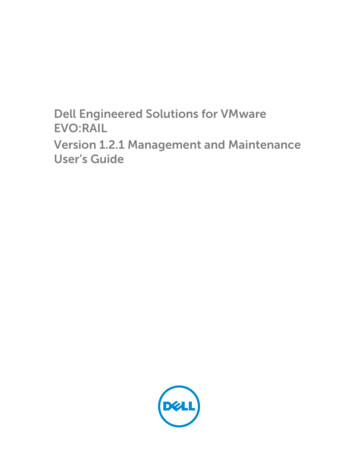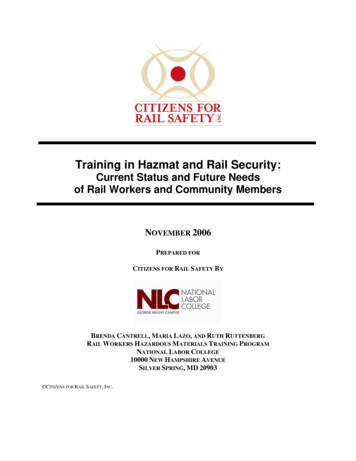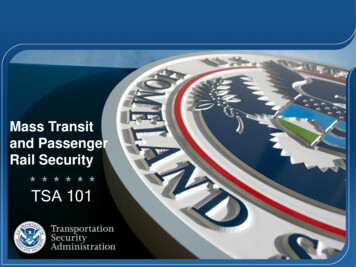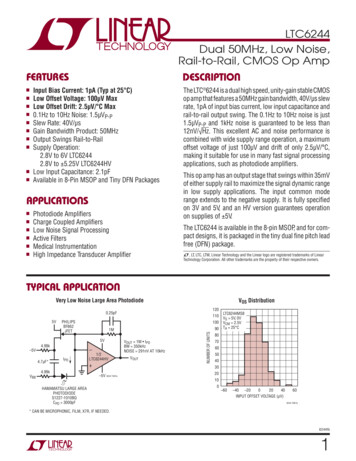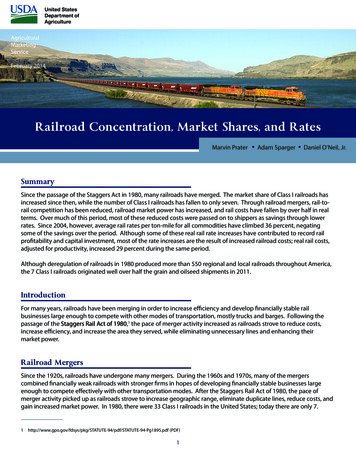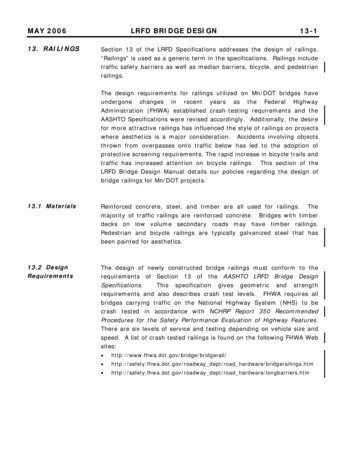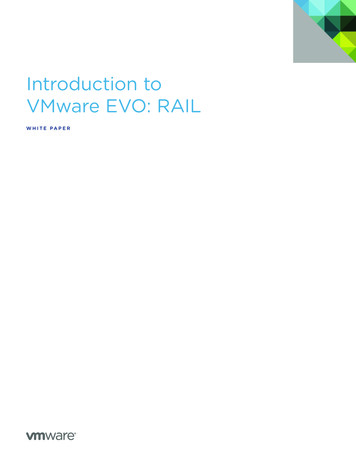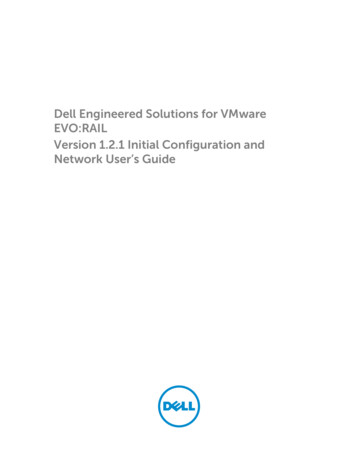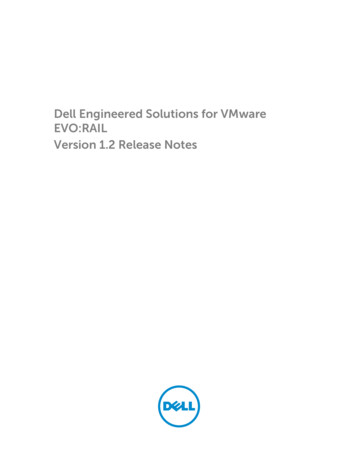
Transcription
APTA STANDARDS DEVELOPMENT PROGRAMRECOMMENDED PRACTICEAmerican Public Transportation Association1666 K Street, NW, Washington, DC, 20006-1215APTA RT-RMT-RP-001-10Approved June, 2010Vehicles Training Joint SteeringCommitteeRail Vehicles Maintenance TrainingStandardsAbstract: This Recommended Practice establishes standards for a program of rail vehicles maintenancetraining.Keywords: training, rail vehiclesSummary: In response to the transit industry’s need for rail vehicles maintenance training, theTransportation Learning Center has partnered with APTA, transit agencies and unions representing transitworkers to develop these joint labor-management training guidelines and recommended training practices.Scope and purpose: The curriculum, courseware and training guidelines adopted by the group andcontained in this Recommended Practice are designed to meet or exceed the licensing requirements ofjurisdictions, which currently or in the future, may legislate professional licensure or certification for railvehicle technicians. The apprenticeship program will ultimately be registered by the U.S. Department ofLabor’s Office of Apprenticeship.This Recommended Practice represents a common viewpoint of those parties concerned with its provisions, namely,transit operating/planning agencies, manufacturers, consultants, engineers and general interest groups. Theapplication of any standards, practices or guidelines contained herein is voluntary. In some cases, federal and/or stateregulations govern portions of a rail transit system’s operations. In those cases, the government regulations takeprecedence over this standard. APTA recognizes that for certain applications, the standards or practices, asimplemented by individual rail transit agencies, may be either more or less restrictive than those given in thisdocument.
Contents1. Objective of this standard . 11.1 The Steering Committee . 1ParticipantsAPTA appreciates the VehiclesTraining Joint SteeringCommittee, which provided theprimary effort in the drafting of thisRecommended Practice:Co-ChairsJohn Costa (ATU Local 819)Jay Shah (NYC Transit)2. Rail vehicles maintenance training guidelines . 22.1 100-level courses: Fundamental Skills for Transit Maintenance . 22.2 200-level courses: Vehicle Operations Overview andMaintenance of Rail Vehicles . 152.2.1 250-level courses: Overhaul and Rebuild of Rail VehiclesComponents . 602.3 300-level courses: Advanced Theory of Operation andTroubleshooting of Systems . 63Atlanta (MARTA/ATU Local 689)Frank HarrisReferences . 73Boston (MBTA/IBEW Local 103)Robert Perry, John BurrAbbreviations and acronyms . 73Chicago (CTA)James PlominDenver (RTD Denver)Phil EberlLos Angeles (LACMTA/ATULocal 1277)Gary Dewater, James Avila, JimLindsayMinneapolis (Metro Transit/ATULocal 1005)Paul Swanson, Jack ShawNew JerseyKen BoucherNew York City (TWU Local 100)Rodney Glenn, Hector RamirezPhiladelphia (SEPTA/Local 234)Brian Miley, Phillip LowePittsburgh (ATU Local 85)Adam WilliamsPortland (ATU Local 757)Joseph RuffinSacramento (SacramentoRegional Transit District/IBEWLocal 1245)Kerry Kopp, Michael Ornelas,Bertrand AlexanderSalt Lake City (Utah TransitAuthority/ATU Local 382)Randy Welsh, Todd SimonsSan Jose (ATU Local 265)Ed DoloresWashington, D.C. (ATU Local689)Bryan MatthewATU International/APTABob Hykaway, John RemarkPam Boswell 2010 American Public Transportation Association
APTA RT-RMT-RP-001-10 Rail Vehicles Maintenance Training Standards1. Objective of this standardPublic transportation faces a technical skills shortage driven by changing technologies, shifting workforcedemographics, record-breaking growth in ridership and the continuing expansion of transit systems and users.Industry leaders acknowledge that the pace of technological change has surpassed the capacity of mostagencies to train skilled technicians and new entrants/employees in the effective diagnosis, repair andmaintenance of advanced capital equipment. To address many of these issues, labor-management partnershipshave been advocated in a number of blue-ribbon reports (see References) from the Transportation ResearchBoard and its Transit Cooperative Research Program (TCRP) as well as from the American PublicTransportation Association (APTA).1.1 The Steering CommitteeThe development of recommended training guidelines was coordinated through a joint labor-managementSteering Committee of subject matter experts drawn from rail transit agencies across the country. Table 1lists the participants.TABLE 1Traction Power Training Joint Steering Committee MembersStateCityAgencyUnionCaliforniaLos AngelesLACMTAATU 1277CaliforniaSacramentoSacramento RegionalTransit DistrictIBEW Local 245ColoradoDenverRTD DenverDistrict of ColumbiaWashingtonFloridaMiamiMiami Dade husettsBostonMTAATU Local 589MinnesotaMinneapolisMetro TransitATU Local 1005New MexicoSan JoseNew YorkNew York CityNYCTTWU Local 100PennsylvaniaPhiladelphiaSEPTATWU Local 234PennsylvaniaPittsburghNew JerseyNewarkOregonPortlandUtahSalt Lake CityATU Local 689ATU Local 732ATU Local 265ATU Local 85New Jersey TransitATU 819ATU 757Utah Transit AuthorityATU Local 382Other participants: APTA, ATU InternationalMeeting over a period of two years, this committee of management and labor subject matter experts: Determined the job responsibilities and related tasks required of rail vehicles mechanics.Determined the skills, knowledge and abilities required to successfully execute the job responsibilitiesand tasks of the craft.Developed a program of training and order of instruction for classroom and on the job training. 2010 American Public Transportation Association1
APTA RT-RMT-RP-001-10 Rail Vehicles Maintenance Training Standards Determined the learning objectives associated with each phase of the training process to develop railvehicle mechanics.2. Rail vehicles maintenance training guidelinesThe safe and efficient operation of transit rail systems is highly dependent on having fully operational railvehicles to satisfy schedule needs. As with most transit and rail occupations, a shortage of skilled vehiclemechanics exists. The inadequate numbers of rail vehicle maintainers is attributed to several factors, includingthe pending retirement of incumbent workers, the continued expansion of rail transit systems nationwide andinadequate recruitment and training of mechanics. The difficulty recruiting new entrants into the field isexacerbated by the need to require shift work of newer employees.In response to the need which the transit industry expressed for rail vehicles maintenance training, theTransportation Learning Center has partnered with APTA, transit agencies and unions representing transitworkers to develop joint labor-management training guidelines and recommended training practices. Thedevelopment of these training guidelines was supported through grants from the U.S. Department of Labor,the Federal Transit Administration and the Transit Cooperative Research Program. Specifically, TCRP projectE-7 deals with the researching and development of a national certification program for rail vehicle mechanics.Rail vehicles maintenance training guidelines are organized into 12 subject areas corresponding to thedifferent job responsibilities of a rail signal maintenance technician. These subject areas:1.2.3.4.5.6.7.8.9.10.11.12.CouplersTruck and axlePropulsion and dynamic brakingAuxiliary inverters and batteriesFriction brakesHVACCurrent collection and distributionMonitoring and diagnosingCar bodyDoorsCommunications systemsATP-ATOThe labor-management subject matter experts on the Vehicles Training Joint Steering Committee developedthe training curriculum and guidelines with the expectation that training would be instructor-led and includeon-the-job training under the supervision of an experienced and qualified journeyman or technician.2.1 100-level courses: Fundamental Skills for Transit Maintenance100. Property-specific orientation (including track safety, flagging, emergencyevacuation)101. Orientation and background 101-1. General Safety OverviewName the agencies and organizations that make and enforce safety regulationsName several electrical shock hazards and the techniques used to prevent those hazardsName the four classes of fire and how to extinguish themDescribe the technique used to lift a heavy loadExplain the importance of PPE and name several typesExplain what MSDS stands for and how it applies, RtKConfined space training 2010 American Public Transportation Association2
APTA RT-RMT-RP-001-10 Rail Vehicles Maintenance Training Standards 101-2. Customer ServiceCrowd controlOperational signage101-3. System SecurityPresentation by jurisdiction security force101-4. Station OrientationExplain how to use the transit system and locate all stations101-5. Safety and Emergency ProceduresExplain how to reach both internal and external emergency service personnel101-6. Public SafetyDemonstrate the proper barricade setup for both elevator and escalators102. Electrical and Job Safety 102-1. Developing a Safe AttitudeSafety overview; personal responsibility102-2. Using Personal Protective Equipment (PPE)Discuss safety rules concerning PPEDetermine when and what PPE is required for a jobDemonstrate the proper use of various PPEExplain the proper care and storage of PPE102-3. Understanding Electrical SafetyState (by jurisdiction) electrical safety rulesExplain basic electrical concepts of current, voltage, resistance and insulationDiscuss the hazards of electricityDiscuss methods used to prevent electrical accidentsUse scientific notation and metric measurements102-4. Lockout/TagoutDiscuss the importance of using correct lockout/tagout proceduresIdentify various types of lockout and tagout devicesExplain how to use lockout/tagout devices102-5. MSDS (right to know)Recognize the importance of safety and its priorityDiscuss OSHA laws and their relation to authorityExplain how chemicals in the workplace can be a hazardObtain and use material safety data sheetsProperly label, store and dispose of hazardous chemicalsDiscuss methods used to determine exposure to hazardous substances, and how to minimize harmfuleffects103. Tools and Material Handling 103-1. Basic Hand ToolsMeasuring tools:- Explain how to hold a rigid rule correctly when measuring an object and show from whichpoint the measurement begins- Describe how to set lock joint transfer-type calipers- Identify vernier calipers- Explain how to take a measurement with a micrometer caliper- Name the parts of a combination squareWrenches and screwdrivers:- Identify types of materials used for making wrenches 2010 American Public Transportation Association3
APTA RT-RMT-RP-001-10 Rail Vehicles Maintenance Training Standards- Identify open-end, box-end, socket, socket-head, adjustable, torque and striking-facewrenches- Describe two sizes that are important in identifying a socket wrench- Identify standard, Phillips, offset and spiral-ratchet screwdrivers- List the steps to follow when driving a screwPipefitting tools:- Identify a straight pipe wrench, a Stillson wrench, a chain pipe wrench, a strap wrench and acompound-leverage wrench- Explain how to use a pipe wrench- Explain why a machinists’ vise should not be used for holding pipe- Explain how to thread pipe- Explain how to clean a pipe tool- Explain how to cut and flare tubing- Explain procedures for brazing- Demonstrate the ability to braze a section of pipePlumbing tools:- Explain how to use a mechanical tubing bender- List the steps in joining hubless pipe- Explain why the drain pipe should be completely covered by the force cup- Name the criteria used in selecting line clearing tools- List the steps in measuring pipe when using the center-to-center measuring systemsElectrician’s tools:- Explain how to use an EMT bender- Explain and demonstrate the use of an analog and digital meter- Name the uses of the all-purpose tool- Demonstrate the use of the all purpose tool- Explain the use of a knockout punchSheet metalworking tools:- Identify the different types of snips and punches- List six safety practices to follow when working with sheet metal- Describe different types of sheet metal- Demonstrate the ability to measure the thicknesses of sheet metalMetalworking tools:- Demonstrate the ability to select the proper hacksaw blades for cutting various materials- Explain the difference between single-cut and double-cut files- List the types of taps usually found in a tap set- Explain how to cut an external thread on a bolt, screw or stud- Explain how to remove a reamer from a holeHoisting and pulling tools:- Explain how to prevent synthetic and fiber rope from unraveling- Explain how individual wires and strands of wire are formed into wire rope- Identify the most appropriate sling for use near corrosive chemicals- Identify a slide-hammer puller- Describe the different kinds of slings and loads103-2. Basic Power ToolsElectric drills- Name four parts that are common to both the light-duty drill and the heavy-duty drill- Name the parts of a drill bit- Explain how to drill a blind hole- List the safety rules to follow when using electric power tools 2010 American Public Transportation Association4
APTA RT-RMT-RP-001-10 Rail Vehicles Maintenance Training StandardsElectric hammers:- Explain the difference in hammering action between a percussion hammer and a rotaryhammer- Select the proper chisel to use for each of the following jobs: brick cleaning; generaldemolition work; edging, chipping and channeling; and removing floor tile- List the precautions that should be taken to ensure electrical safety when using an electrichammer- Name two safety items to use when operating an electric hammer in damp or wet areasPneumatic drills and hammers:- Explain how drill size is determined- Describe the chiseling action of a bull point chisel when it is used to clean masonry seams- Describe how to use a rivet buster- Explain drill speed requirements- Identify various types of drill bits used in pneumatic hammersScrewdrivers, nutrunners and wrenches:- Identify the operating advantages of pneumatic tools- Define stalling torque- Describe the clutch action of direct drive, positive drive and adjustable torque drive- Explain how to install a bit in an electric screwdriver- Describe how to install multiple fasteners correctly in a circular pattern- List safety rules to follow when using power screwdrivers and wrenches- Describe the difference between pneumatic and electric nutrunnersLinear-motion saws:- List other names for both the saber saw and the reciprocating saw- Describe the cutting action of a saber saw- Explain how to draw a saw blade with regular set teeth and one with wavy set teeth- Explain how to plunge cut a rectangular opening- List the types of band saw blades described in this lesson and a few characteristics of eachCircular saws:- Name the major parts of a circular saw- Describe the cutting action of a circular saw- List the factors that determine feed speed- State the definition of an arbor- Identify different types of bladesElectric sanders:- Explain how to install a sanding belt- Identify different types of sanding belts- Explain how to flush the gear chamber of a belt sander- Discuss the assembly of a sanding disk- List the safety rules to follow when using a disk sanderGrinders and shears:- State the meaning of each symbol in the six-symbol standard marking system for grindingwheels- Explain the correct procedure for mounting a grinding wheel- List safety rules to follow when using a grinder- Discuss how to maintain grindersTool sharpening:- State the reasons for sharpening tools- Explain the use of whetstones- Identify a bench stone 2010 American Public Transportation Association5
APTA RT-RMT-RP-001-10 Rail Vehicles Maintenance Training Standards- Explain how to sharpen taps, dies, screwdrivers and chisels103-3. Moving Machinery Using a DollyIdentify the different types of dollies and their useDescribe the safe procedure of using dollies103-4. Moving Machinery Using Roller PipesExplain the difference between wood and steel pipesDetermine the proper number of rollers requiredExplain roller frictionDescribe the use of shoes and skids with rollers103-5. Assembly of Gantry CraneDescribe the proper use of and limits of a gantry craneIdentify the parts of and inspection procedures for eachProperly assemble using correct steps and proceduresUnderstand the proper use, inspection and assembly of103-6. Rigging and HoistingDescribe the theoretical principles of the seven basics of mechanismsSolve basic mechanism problems using concepts of mechanical advantage and friction lossIdentify the types of rigging jobs in which load equalization or load distribution are necessaryIdentify the basic rigging safety guidelinesPerform necessary calculations for load equalization and distributionDescribe and classify the various type of wire rope, fiber rope and chainsProperly inspect wire rope and chainIndentify various types of slings and their proper useDescribe the common types of sling hardware and their proper useDemonstrate how to calculate the efficiency of a reeving system104. Mathematics 104-1. Whole Numbers and Arithmetic OperationsDemonstrate the ability to add, subtract, multiply and divide whole numbers with numbers with anaccuracy of 75 percent or greaterIdentify the place value of digits in a whole numberIdentify and list the prime numbers between 0 and 100Demonstrate the ability to round whole numbers and approximate whole numbersDemonstrate the ability to solve application (word) problems104-2. Integers and Order of OperationsDemonstrate the ability to add, subtract, multiply and divide signed numbers and integers with anaccuracy of 75 percent or greaterIdentify exponential notationIdentify a radicalDemonstrate the ability to work with positive and negative numbers on a calculatorDemonstrate the ability to solve problems observing the order of operations104-3. Decimals and PercentsDemonstrate the ability to add, subtract, multiply and divide decimals and percentages with anaccuracy of 75 percent or greaterDemonstrate the ability to read, order and round decimalsDemonstrate the ability to multiply and divide by the powers of 10Demonstrate the ability to convert from percent to decimal and decimal to percentDemonstrate the ability to calculate percentages 2010 American Public Transportation Association6
APTA RT-RMT-RP-001-10 Rail Vehicles Maintenance Training Standards 104-4. FractionsDemonstrate the ability to add, subtract, multiply and divide fractions with an accuracy of 75 percentor greaterDemonstrate the ability to change improper fractions into mixed numbers and mixed numbers intofractionsDemonstrate the ability to reduce a fraction to its lowest termsDemonstrate the ability to convert fractions to decimals and decimals to fractionsDemonstrate the ability to determine equivalent fractions104-5. Measurements and ApplicationsDemonstrate the ability to work with operations of powers of 10Demonstrate the ability to work with zeros as an exponent, negative exponents, scientific notation andengineering notationDemonstrate the ability to work with applications of length, weight, area and volumeDemonstrate the ability to convert between the customary and metric systems104-6. Algebra: Basic OperationsDemonstrate how to calculate the value of an expression by performing mixed operations in thecorrect orderDemonstrate how to write an algebraic equation, based on a relationship stated in wordsDemonstrate how to solve an algebraic equation for a specific variable105. Introduction to Electricity 105-1. Review Electrical Safety105-2. Fundamentals of ElectricityPower supply, distribution and usage105-3. Introduction to Electrical Symbols, Schematics and Print Reading105-4. Motors Transformers and Switches106. Electrical Meters 106-1. Multimeter BasicsExplain how meters are used to measure current, voltage, and resistance106-2. Use of Meter to Measure106-3. Meter Safety106-4. Understanding Meter Types107. Wiring Technologies and Equipment 107-1. Safety Rules in Power ElectronicsDiscuss and list the safety rules for avoiding electrical shockDescribe several causes of electrical burnsKnow the reason for grounding of electrical equipmentDetermine dangerous levels of electrical current as it relates to the human bodyPhysiological effects of electric current on the human bodyRules for safe practice and avoiding electric shockAvoiding burns and avoiding equipment related injuries107-2. Wiring Tools and Insulation RemovalDiscuss and identify by name the different types of hand tools associated with wireDemonstrate the ability to strip various types of insulation materials from different gauges of wireHand toolsStripping techniquesDemonstration and practice 2010 American Public Transportation Association7
APTA RT-RMT-RP-001-10 Rail Vehicles Maintenance Training Standards 107-3. Hand Splicing TechniquesDemonstrate the ability to make each of the splice types discussed and demonstrated:- Western Union- Twisted pair- Fixture joint- Knotted tap107-4. Mechanical TerminalsKnow the maximum allowable temperature for heat shrink tubingDemonstrate the ability to make several wire splice connections utilizing wirenutsDemonstrate the ability to install heat shrink tubing on various wire connections- Wire nuts and bolt splices- Snap-lock splices- Splice insulation107-5. Electrical Wiring, Connector and Terminal RepairDiscuss the advantage of crimped terminal repairs vs. solderingDemonstrate the ability to install various sizes of crimp-on wiring terminals both insulated and noninsulatedExplain the difference in terminals and splices used on aluminum wiring as compared to other wiringmaterialsDiscuss why pre-insulated terminals and lugs are color-coded- Non-insulated terminals and splices- Specialized terminals for aluminum wire- Preinsulated terminals lugs and splices- Specialized crimping techniques107-6. Solder and Soldering ProcessDiscuss the advantages of using soldering to join two pieces of metal together as an electrical pathDiscuss the nature of solder and the wetting actionExplain the proper technique for applying solder and handling the soldering iron during the solderprocessDemonstrate the ability to correctly tin various sizes of stranded wireIdentify the correct tolerances allowed for insulation clearance when soldering to different types ofterminalsExplain the various wrapping techniquesReview and discuss the steps of the soldering processExplain why flux is used in the soldering processDemonstrate the ability to properly wrap and solder various types of electrical terminationsIdentify the characteristics of both acceptable and unacceptable solder connections in accordance withacceptable standardsDemonstrate the ability to perform leaded and lead-free soldering107-7. Printed Circuit Board FundamentalsDiscuss the various manufacturing methods for hole-through, surface-mount and mixed technologytypes of circuit boardsExplain proper handling, shipping and storage of circuit boardsDemonstrate knowledge of electrostatic discharge using grounding straps and other dissipativedevicesIdentify all types of active and passive components and their orientation on the circuit boardDiscuss various methods of inspection and inspection devicesDemonstrate the ability to find visual defects of circuit board components and solder joints inaccordance with acceptable standardsDemonstrate the ability to replace hole-through and surface-mount devices 2010 American Public Transportation Association8
APTA RT-RMT-RP-001-10 Rail Vehicles Maintenance Training Standards108. DC Fundamentals 108-1. Safety Rules in Power ElectronicsDiscuss and list the safety rules for avoiding electrical shockDescribe several causes of electrical burnsKnow the reason for grounding of electrical equipmentDetermine dangerous levels of electrical current as it relates to the human bodyPhysiological effects of electric current on the human bodyRules for safe practice and avoiding electric shockAvoiding burns and avoiding equipment related injuries108-2. Science of Electricity and ElectronicsIdentify the relationship between elements and compoundsDiagram a model of an atomDiscuss the concepts of atomic weight and atomic numberState the law of charges and explain it using examplesExplain what is meant by electric current, voltage and resistanceDescribe the two theories of current directionDistinguish between conductors, insulators and semiconductorsState and explain Ohm’s law108-3. Basic Instruments and MeasurementsExplain and demonstrate the correct procedure for using an ammeter, a voltmeter and an ohmmeterDiscuss the difference between a DMM and a VOMInterpret a linear scaleInterpret a nonlinear scaleCalculate the values of shunt resistors and multiplierDiscuss the concept of meter sensitivityUnderstand basic electrical diagrams108-4. Circuit Materials, Energy and Source of ElectricityIdentify different conductor and insulator materialsDiscuss the factors that affect resistance in a conductorIdentify different types of switching devicesIdentify different types of resistorsDetermine the value of color coded resistorsCalculate electrical power in wattsConvert horsepower to wattsDefine polarization as it relates to an electrical circuitDetermine efficiency of an electrical circuitCombine Ohm’s law and Watt’s law to find unknown values in a given circuitDiscuss different sources of electrical energyExplain the difference between primary and secondaryCalculate the outputs of batteries connected in series and parallel108-5. Series CircuitsDetermine the total resistance of a series circuitDetermine the voltage drops in a series circuitDetermine the current values of a series circuitDetermine the wattage values of a series circuitApply Ohm’s law to solve for unknown voltage, current and resistance in a series circuitApply series circuit theory to assist in troubleshooting a series circuit108-6. Parallel CircuitsDetermine the total resistance of a parallel circuitDetermine the voltage drops in a parallel circuit 2010 American Public Transportation Association9
APTA RT-RMT-RP-001-10 Rail Vehicles Maintenance Training Standards Determine the current values of a parallel circuitDetermine the wattage values of a parallel circuitApply Ohm’s law to solve for unknown voltage, current, and resistance in a parallel circuitApply parallel circuit theory to assist in troubleshooting a series circuit108-7. Combination (Series-Parallel) CircuitsDetermine the equivalent circuit resistance for a given combination circuitDetermine the voltage drops in a combination circuitDetermine the current values of a combination circuitDetermine the wattage values of a combination circuitApply combination circuit theory to troubleshoot a combination circuit109. AC Fundamentals 109-1. Alternating Current PrinciplesExplain how a generator is used to produce alternating current using a graph to show a typical ACwaveDefine and calculate average (avg), effective (rms), instantaneous voltage (Vinst) and voltage peak topeak (vpp)Demonstrate the ability to operate an oscilloscope while performing typical circuit measurements(amplitude, frequency, time, phase, etc.)Determine voltage both AC and DC using an oscilloscopeDetermine the frequency of a waveform using an oscilloscope109-2. TransformersExplain and demonstrate important operating characteristics of single-phase transformersConnect transformer windings in series-aiding or series-opposing configurationsCalculate the current and voltage ratios for a given transformerDetermine the phase relationship of a transformer primary to secondaryDetermine the frequency of a waveform using an oscilloscope109-3. Series Circuits109-4. Parallel Circuits109-5. Combination (Series-Parallel) Circuits109-6. Basic Troubleshooting Theory (AC-DC)110. Basic Hydraulic and Pneumatic Theory and Applications 110-1. Safety Rules in Power Hydraulics and Pneumatics110-2. Basic Hydraulic PrinciplesHydraulic pumps, valves, actuators110-3. Basic Pneumatic PrinciplesPneumatic pumps, valves, actuators110-4. Basic Hydraulic and Pneumatic Symbols, Schematics and Print Reading111. Basic Mechanical Theory and Application 111-1. Mechanical Power TransmissionDiscuss the different styles of belts that are used in industryDiscuss the benefits of a positive-drive beltDiscuss the benefits of a chain drive systemDiscuss the use of gears and gearboxesDefine pitch diameter, circular pitch, pitch line and gear ratioPerform speed calculations for belt drives, gear drives and chain drivesAssemble and perform alignments on belt drives, gear drives and chain drivesProperly tension belts and chains 2010 American Public Transportation Association10
APTA RT-RMT-RP-001-10 Rail Vehicles Maintenance Training Standards 111-2. Pumps and CompressorsList types of pumps in use todayExplain and calculate volumetric efficiencyExplain and calculate the delivery of a pumpDiscuss some of the common problems that may be encountered while troubleshooting a pumpDiscuss some of the common problems that may be encountered while troubleshooting a pump111-3. Fluid PowerDiscuss some fluid power fundamentalsExplain psi, psig, psia, and inches of mercury ("Hg)Understand how force is transmitted through a hydraulic systemUnderstand the effects of compressing air for a fluid power systemLear
Miami : Miami Dade Transit . Georgia . Atlanta : MARTA . ATU Local 732 : Illinois . CTA : Chicago . Massachusetts . Boston : MTA . ATU Local 589 : Minnesota . Minneapolis : Metro Transit . . Explain how to use an EMT bender -Explain and demonstrate the use of an analog and digital meter -Name the uses of the all-purpose tool -
